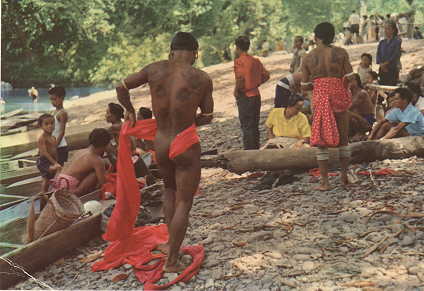

Despite being among the most basic markers of cultural identity, the loincloth has been distinctly ignored. Anthropologists generally give a word or two regarding it, then pass on to other matters, and writers on costume ignore the topic altogether. When I came to study Borneo, I tried to find a description of what the Borneo loincloth was and how to wear it. For as the Dutchman Karl Martin said of the Sulawesi loincloth a hundred years ago, "once it's on it's hard to figure out how it got that way."[1] Many Dayaks who have grown up in modern city life, or even farther out, are as much at a loss for the method of putting on a loincloth as any western man. Much as the western man now finds it difficult to tie a bow tie!
There are several reasons why western writers would not want to write much about the loincloth. In the first place, mere unfamiliarity.[2] European men's dress is an "arctic" style based on trousers and the shirt, which they inherited from the Romans. According to archaeological evidence,[3] European men have been wearing trousers from the remotest past, even when they too were "primitive." With negligable exceptions,[4] they have never worn any kind of loincloth. The only thing in Europe which resembles it is underpants, a garment that has a history of scarcely a thousand years and whose dignity and consequent esthetic value has been nil.
Second, though the purpose of the loincloth is to cover the male genitals, it leaves the buttocks bare. Most peoples feel shame about all or part of the genitals; but it seems to be a peculiarly western trait to feel equal shame about the buttocks, probably from a fear of homosexuality, an anxiety which also seems to grow with civilization. Hence, westerners have always considered the loincloth an immodest garment.
In daily life Europeans felt very uncomfortable with any kind of exposure, to the point that a peasant would not work with his shirt off even on a hot day. Only the ancient Greeks, whose clothing consisted of a single wrap, felt no shame about the naked body. This attitude has survived in western art's genre of the nude.
Clothing, which in its broadest sense includes ornaments and paint, is universal: there never has been such a thing as a naked people. Human beings have a horror of being nude, of being shamefully bare, which does not necessarily mean that the genitals can be seen. In the case of South American Indians, nudity meant appearing without appropriate ornaments or paint, something one would only dare to do while working in the garden when no one was looking.[5] You notice in photographs that the Penan, even on their hunting trips, wear their strings of beads and fiber bracelets.
There are, as I see it, four main functions of clothing, all equally important: ornament, modesty, protection, and the feeling of something on the body or constricting it.
The most profound function of clothing, in this widest sense, is to ornament the body, and thus to "humanize" and "socialize" it. Some South American Indians have expressly said that they ornament themselves because if they wear no ornament they feel there is no difference between themselves and animals. Ornament is a necessity for them to keep their identity as human beings in the vast and often terrifying forest. It is an expression of play, delight, and willed human beauty. For the same reason, the Balinese and other southeast Asian peoples formerly abhorred white teeth. They felt white teeth were a sign of animality, and hence they blackened them with iron salts in order to look distinctly human.[6] Ornament is also one way a person can show something about his standing and his life. The tattoos that an Iban man had pricked on him (which can also be considered a type of clothing) after say, bejalai, are an example of this.
The universal human feeling of modesty must also originate from this anxiety to be distinguished from animals, to put human order into overwhelming natural creation. Animals live their sexlives completely in the open and mix with any degree of kin. Human beings control their sexuality and respect the stringent and universal prohibition against incest. The Nambikwara of Brazil went completely naked, and never allowed themselves to become sexually excited in public. This was their way of modesty.[7]
Nakedness is nevertheless always erotic. Though eros is an essential of human life, unrestricted eros is both dangerous and "inhuman." Usually peoples have felt that they ought to render the genitals symbolically harmless with some covering or decoration. Many men of South American, Africa, and Melanesia felt ashamed that any other person should see their glans penis, and thus covered it with sheaths of leaves, or in the case of the Panamanians, of gold.[8] The men of the Yanomami tribe formerly tied up their penises to belts around their hips,[9] and they felt ashamed if their penises came undone, even in a fight.[10] Other peoples circumcise the penis, either because religion demands it or because (as is become customary among the natives of Borneo) the women are repelled by penis with foreskin intact. In Borneo, only antu are carved or depicted in weavings as entirely naked, a sign of their crude, powerful, half-animal nature.
But these coverings ornament and attract attention to the genitals as much as hide them. Their function is in fact not so much to hide the penis as to ornament it, humanize it and socialize it. Westerners misinterpret the erotic significance of the penis sheath; those who wear them consider them equipment for modesty and decency. Their function is to help create a humane balance in sexuality. The "primitive" man does not at all deny his virility, but displays it in such a way as to indicate also that he controls his sexuality and channels its energies in a socially responsible way. The often beautifully decorated front apron of the Bornean loincloth must likewise be a humane display of a man's sexuality, as much as is the sporran of Scotsmen's traditional dress.[11]
People in warm climates felt no false shame over going completely nude if necessary. It is interesting that the Igorots of Luzon, who speak a Malayo-Polynesian language and in many respects resemble the Dayaks of Borneo, were on occasion quite careless of being seen naked. Women took off their skirts and put them under their hats if it began to rain, and a photograph shows naked men in company with women (dressed in banana leaves) doing the messy work of churning up a rice field for planting.[12] I have heard of only one or two instances of Dayak men going naked like this. Dayaks in general are shocked at the idea. But a photograph of thirty years ago shows a Penan man entirely naked as he hauls a catch of fish out of a river.[13]
Thus, utility has always been a difficult justification for many types of clothes, especially in a tropical climate where they are not necessary at all.[14] How useful are high heels? or blue woolen suits such as we see bankers wearing on the streets of Kuala Lumpur? If utility were consulted, a loincloth would seem much more practical, a point that "primitive" men have made rather often, when they don't actually come out and say that wearing trousers is indecent.[15] To traditional tropic dwellers, the comfort of a cool body outweighs considerations of being scratched in the jungle, and modesty complies. Modern dress functions prominently as a complicated symbolic system for asserting status, and a blue suit in Malaysia is an especially Veblenesque piece of conspicuous consumption.
The last main reason for the wearing of clothes is the universal desire to do something with the body, to paint it, tattoo it, scarify it, to feel something constricting it.[16] It feels good to wear ornaments, paint, strings, and bracelets. Some peoples who do not cover their genitals enjoy simply wearing belts. A loincloth to a man gives the pleasing feeling of a band holding belly and genitals. It lets him feel his body, his nakedness and being, ornamented with something else. A loincloth is something put on the body. Western clothes that cover everything reshape the person entirely.
Now and again someone asks regarding the loincloth: "But can it be
comfortable?" I assure them that it is.
ALTHOUGH at one time anthropologists who were
guided by the idea of "progress" thought that people began naked,
progressed to little
piece of bark or tassels, etc., "to hide the shame," then went on to
invent
breechcloths and loincloths, and at last skirts and trousers, we can
really
discover no such sequence. The simplest sort of men's garment that
westerners
can recognize as such is a strip of skin, bark, cloth, or whatever,
passed
between the legs and secured front and back by a belt. This we English
speakers
(who have been late in finding names for such things) ought to call a
"breechcloth."
Even this is a misnomer, because its function is to cover the genitals,
and
not the buttocks or "breech." The Yami people of Botel Tobago Island,
off
southern Taiwan, demonstrated to two Japanese anthropologists how in
very
ancient times their men used large leaves for their strip,[17] which
presumably they
changed often, just as some Melanesian men plucked fresh leaves daily
for
their penis sheaths.
Barkcloth was doubtless certainly in use before woven cloth was, and it's natural to think that barkcloth was early used for breechclouts. Although Mangyan men of Mindoro in the Philippines still wear breechcloths as well as loincloths, there is no evidence either way for use of breechcloths in Borneo in the remote or historical past. In the Pacific region, the penis sheath is restricted to the Melanesian cultural area.[18]
Barkcloth can be produced easily in a long strip, and with that one has the material for making an actual loincloth, that is, a single piece of material that is both breechcloth and the belt that holds it. Such is what Hawaiian men wore before the Europeans arrived, and it's natural to believe that other Malayo-Polynesians did the same. A loincloth is easily perceived as more stylish than a breechcloth, and is definitely more comfortable, because the belt is broader, softer, and does not need to be cinched so tight.[19] When weaving appears, textiles are used for the loincloth, and when commercial cloth is imported, that is used.
In speaking about Borneo, I use the term "loincloth" throughout. Although European writers of the last century commonly used the Malay term chawat for the Borneo dress,[20] in current Bahasa Malaysia/Indonesia the word denotes such things as babies' diapers and beggars' rags and lacks dignity. To adopt the Iban term sirat would imply that I give preference to that language.[21] Throughout Borneo the loincloth is pretty much the same for all peoples, although different peoples undoubtedly wore it in subtly distinct styles.
The loincloth is a garment of great antiquity, the original men's clothing of most of the world, and particularly of the Malayo-Polynesian area, which includes the islands of the Pacific Ocean as far east as Hawaii and as far south as New Zealand,[22] the Malay Archipelago and the Philippines, the Malay peninsula, the island of Madagascar to the west, and mainland places inhabited by such Dayak-like peoples as the Mnongs of Vietnam, the Mru of Bangladesh and the Nagas of Assam.[23] On the continent west of India the loincloth is unknown. In Malaya, Java, Bali, and elsewhere, the loincloth was replaced by the skirtlike kain because of Hindu influence,[24] while the sarong (a sewn tube of cloth) is an Islamic import. It is worth noting that in the Balinese wayang kulit, the most venerable character, Twalen, wears a loincloth and not a skirt. Twalen is both a funny rustic servant and one of the highest of gods, and it has been suggested that his character represents the pre-Hindu and animist "native" nature of the Balinese.[25]
At this point, I ought to give the reader, who has been waiting, directions on how to make a generic loincloth, something that would pass for clothing among the right circles in Borneo, the Philippines, or the Amazon.
Take a strip of material about 10 inches wide and 10 to 12 feet
long.Hold up one end in front with your left hand or chin. The distance
it falls determines the length of the apron. Pass the rest of the
material between your legs to
the back and bring it up from back to front, from right to left around
your
waist (the other way if lefthanded). Wind it around your waist, and
then,
when you reach again to the back, double the material over and pass it
under
the cloth that comes between your legs, and pull on the loop thus
formed
until belt and pouch are sufficiently tight. There should be a little
"tail"
[iko sirat in Iban] in the back. The loincloth wound this way is
quite
secure and will not fall off even on a hard trek through the jungle.







Simple enough. But as dress is an important medium for individuals as well as whole peoples to express their individual styles, the loincloth too has many variants which we must consider. The Dayak loincloth is hardly a mere cache-sexe. No young man would have been caught dead in a skimpy ragged thing. (Although 140 years ago Spenser St. John found Murut men wearing just that, "chawats....absurdly small, not even answering the purpose for which they were intended."[26]) The standard Borneo loincloth goes at least twice around the waist, and usually more, and the apron and tail will hang at least two thirds of the way down the thighs. The Borneo fashion is to cover a broad band of waist, including the navel, although in the past, men often liked to squeeze the cloth of the pouch and apron very narrow.[27] While in the midst of some chore in which the apron and tail might be dirtied or caught, a man can tuck them into the waistband.[28]
Although Dayaks have been trading with other countries for thousands of years, barkcloth was certainly the original material for loincloths, as it was in Hawaii. Barkcloth was worn quite often in later times, even in the middle of this century, when trade stopped during World War 2 and nobody whether in Kuching or in the ulu could buy cloth. The poor Sebuyau of Lundu, who had by that time abandoned the sirat, were forced to make barkcloth shorts.
This ancient barkcloth loincloth must have been elegant. I have so
far seen only two modern examples. One made as a gift for me by my
friend Michael Gayut is shown in the illustrations. Dayaks preferred
bark from the ipoh tree for its whiteness and softness, and
often gave it a damasked texture by beating it with a carved mallet.
One example is on display at the Sarawak Museum. Later on barkcloth
came to be regarded as a stopgap material. Even Europeans felt that
barkcloth was not up to standard. In the 1870s Margaret Brooke walked
in the Istana grounds with the Rajang rebel Lintong, who had been
captured and brought to Kuching:
Shabbily dressed, his chawat (or waistcloth) was made of bark, and he was naturally not allowed towear his head-dress of feathers which denoted to the Dayak world that he had appropriated human heads. No, Lintong was not smartly dressed when I saw him...[29]
However, men of the Mentawai people of Siberut still prefer barkcloth
to commercial cloth, saying it is more comfortable.[30]
There is a limit to how long a strip of barkcloth can be made. The longest will go only about twice around the waist. Usually the Borneo loincloth is made of a piece of commercial cloth and longer than the minimum twelve feet, often eight to ten yards of cloth and more. Early Brooke officials frowned on this "extravagant waste." The common daily style was to wind the loincloth of a single long length off the bolt, folded in half lengthwise and not cut. Thus it would be about 18 inches wide.
Dayaks preferred to use cloth dyed in some color, especially dark blue, or bright red (kesumba , an assertive color), or black. A cheap cotton such as is still sold in Kuching was acceptable, but one hears even of silk loincloths. Photographs taken by Charles Hose around a hundred years ago show orang ulu men wearing loincloths of white cotton, which seems to have been the fashion in those days. Many photographs from the beginning of this century as well as the 40s and 50s show Dayak men wearing loincloths of cotton printed in a calico or large flowered pattern. It's an old and authentic fashion.[31]
I have seen no old examples of sirats woven in the ikat technique
peculiar to the Ibans, though recent ikat loincloths exist from eastern
Indonesian islands.[32]
It
would be natural to suppose that Iban women did weave them for their
men,
and there is evidence in the following passage of an ensera. Keling
comes
on a night visit to court Kumang [ngayap] and, as he gets up to
leave,
not yet having assurance of her love, she takes the tail of his
loincloth
in her hand. This must have been a very splendid sirat, since it was
the
custom for young men to dress carefully and stylishly for a courting
visit.
Ninga jako orang ka indu munyi nya dia Keling lalu angkat beguai pulai. Sepi iya tak tekait iko sirat. Digama iya tak besabong sama jari."Nama main nuan megai iko sirat aku deh unggal? Enti nuan deka neladan iya tau ga unggal," pia ko Keling.
"Enda ga unggal. Ukai aku deka neladan tanda sirat nuan. Aku enda kala neladan japai jamah orang," pia ko Kumang.[33]
Keling asks: Do you want to copy the designs on the front and tail of
my loincloth? As the great art of Iban women is the design and
execution of ikat
weavings, and since Kumang is in mythology the very greatest weaver,
Keling
here ironically supposes that Kumang wants to examine the ikat design
of
the ends [tanda ] of his sirat.
These tanda are the most important part of the sirat, as they are that which shows, the body of the sirat being hidden under its coils.[34] Women often weave only these decorated ends and stitch them later to a strip of commercial cloth. I have in my collection three such pieces, which are shown in the illustrations.
I have also seen sirats made out of a body of white commercial drill cloth, with separate pieces stitched to the ends. These tanda are thickly embroidered with colored thread, in a style of design I have seen neither on mats nor on pua or other weavings, but most resembling mat designs. The hems of these tanda sirat are decorated with tassels of yarn and little pompoms. I cannot guess how old they are. From their good condition I would guess that these are recently made and were only worn on festival occasions. They also are about 10 inches wide and long enough to pass only twice or three times around the body.
The fashion of the recent present [35] among all Dayak peoples is to wear a loincloth of red, black or dark blue commercial cotton with one broad bar of white, then a bar of color contrasting with the color of the sirat's body, then another bar of white sewn to the apron and tail portions. Dayaks seem to have invented this design in imitation of hornbill feathers.[36] Other loincloths have tanda decorated with appliques of commercial fringe, or, among the orang ulu , with tanda painted in their special own tendril-like designs or with beaded portions.
These modern sirats are very long indeed, and are often wound to cover the middle body completely from the top of the thighs to above the navel. Pictures show that men need help getting into these loincloths. Sometimes excess cloth that passes from under the bunch between the legs is arranged in two huge billowing loops. These can be seen in photographs of Gawai festivals.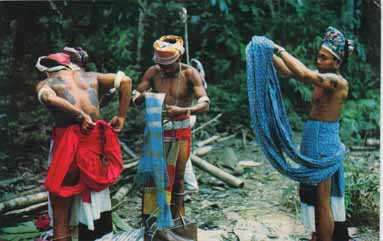
That the fashion of wearing a long sirat that covers much of the body is an old one we have the evidence of a phrase in an historical tale of the time just before the Brooke era: Sirat seduai nyampai di kerigai rusok marang —"The sirats of the two of them reached to their ribs, turning around both sides."[37]
While working or travelling, especially if one is an older man and
does not feel obliged to be fashionable, one can wear a sirat
sabelit
, a "once-wound loincloth," as the Ibans call it: "a work sirat, i.e.
once
round waist and apron just enough for decency." [38] "Sirat Sabelit" is also the name of a
hero of a story recorded by Jepet anak Achoi. He is a young man who
begins as a
diseased and despised outcast, and later with the help of an antu
(spirit) becomes
[ photograph copyright © K. F. Wong, Anna Photo Co.] healthy, beautiful, and honored. His name characterizes him as one so poor and squalid that he takes no care of his clothing. No doubt this refers to his own opinion of his manliness as well.
Also while working or travelling men used to attach a trapezoidal
mat
made of woven rotan, often beaded among the orang ulu, or of bear or
leopard
skin if one could get it, over the buttocks from a string around the
waist.
This is called a tikai burit in Iban and tabin in
Kayan, and
makes a portable, instant seat.
There used to exist a sport of wrestling among the Orang Ulu (not the Iban) akin to
sumo wrestling. In this the loincloth, as in sumo, was important,
as a place to get a hold on. [ photograph by Charles Hose, ca. 1900.]
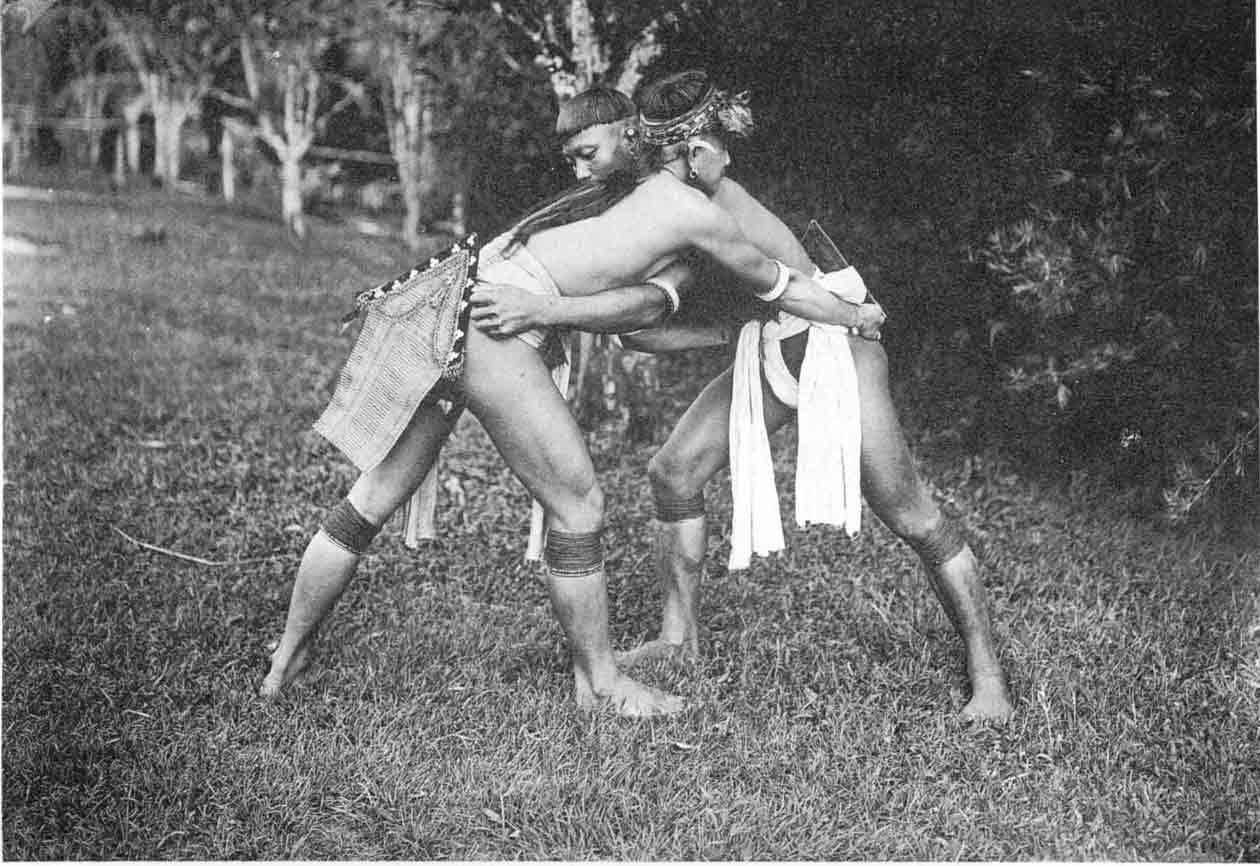
Accessories such as bamboo containers for tobacco or blowpipe darts (temila' in Iban) were fitted with a carved wooden clip so that they could be hooked to the waist of the loincloth. Charms [Iban pengaroh ] were not merely slipped under the loincloth for carrying but tied with a string around the waist.[39] Dayak men undoubtedly also stuck small items to carry in their waistbands. The Iban lost the skill of writing during the general Flood because they carried their papers in their loincloths, while the orang puteh carried theirs in their hats.[40]
In other cultures a boy's putting on the loincloth for the first time was a ceremony that marked his entrance into adulthood. There seems to have been no equivalent among Dayak peoples. Iban boys began to wear the sirat when they began to feel ashamed. According to Sandin[41] a boy at this age is called a sirat-leka , "one on and off with his sirat." One may compare the Dayaks' similarly casual attitude to circumcision, which in Borneo is performed with none of the solemnity which accompanies the operation among the Malays.
Other cultures also have certain customs associated with the loincloth or proverbial expressions concerning it, but I have found none in Borneo. This does not surprise me, since I have seen that Ucko found little symbolism attached to the penis sheath—to us a much more curious garment—among the peoples he studied. A Dayak man can hardly "gird his loins" in the Biblical sense for getting down to business, because he is always so girt. But a writer in a recent New Straits Times[42] discusses the Malay equivalent cawat kote that has become the Kelantan football cry. This means "loincloth the penis," to take the front of the sarong between the legs and tuck it up back to make a loincloth to wear for hard work, so that the penis doesn't waggle around. The Balinese also tucked up their version of the kain this way. Dayak poets pay attention to the loincloth now and again,vespecially the loincloth of a handsome bujang , or those of guests at a festival. The phrase sirat...nyampai di kerigai rusok marang mentioned above occurs as a poetic formula in the Renong cycle. Another expression applied to the tail of the sirat is ujok-ujok : "rising and curving over to the tip," also said of ferns and cocks' tails.[43] The fashion of wearing a long and billowing tail to one's loincloth probably began as an imitation of cocks' plumes. And just as the bars on the apron are derived from hornbill feathers, these loops too are also assertions of virility, for the cock and the hornbill are both manly birds, and appropriate to be imitated in the man's dress.
Dayak men always had to wear at least a loincloth. Photographs show that to appear well dressed a man could not dispense with unus , the calf-rings of demam fiber, and rangki , armlets of shell, stone, porcelain, or silver. A man should always keep his long hair neatly trimmed in the appropriate style [gumba ], wound in a sanggul , and wrapped by a labong . Fashion also obliged him to bear some tattoos. On festive occasions a man should wear all the ornaments he possesses: silver belts and chains, bead necklaces, etc.[44] Men commonly wore a shirt of barkcloth or ikat fabric (a garment perhaps originally derived from quilted armor), and the dress of the manang and lemambang may have a connection with Hindu dress.
It seems to be universal that persons in higher functions--rajahs and war leaders, priests, and partygoers—wear more ornaments and clothes. In Borneo, the lemambang during Gawai wear a long flowered robe, which puts me in mind, given all the well known connections of Dayak religion and Hinduism, of the injunctions of the Sanskrit smrtis and dharmasastras that command a brahman to wear an upper cloth (which, however, can be represented by the upapavitam , or sacred string) while performing religious duties.
Charles Brooke had strong opinions on the desirability of keeping the various races of Sarawak separate, and had noticed the part that dress played in creating racial identity.[45] A visitor in the early part of this century relates that the second rajah required Dayak men to appear in loincloths and appropriate ornaments on official occasions. At the same time he says that Brooke instituted a prize for the best dressed Dayak of the Sarawak Rangers,[46] the ancestor of the present Keling contest.
Finally, it is the opinion of most writers on Borneo from St. John[47] and up that the curious
and persistent story that there are tribes with tails somewhere out in
the jungle began when someone failed to to make out that the tail of
the loincloth was connected to the garment and not the man.
THE loincloth has all but disappeared in Borneo.
It may have been disappearing for a long time, since St. John saw a boy
cast off his loincloth for a new pair of homemade trousers a hundred
and forty years ago,[48]
although until recently one could find older Iban men who were
comfortable in nothing but their sirat. In my travels, I have only once
seen any man wearing it. That was at Rumah Jimbun, Ulu Balleh on Dayak
Day, when an older man threw a length of calico about him over shorts.
The fact that traditional dress is worn on a holiday important to the
Dayak people is evidence of how it
is still seen as part of their cultural identity. Photographs show that
Penan left on their own still wear their avets . Now and then
one sees pictures of men in the Philippines, in remote parts of
Indonesia, and on Pacific islands wearing their loincloths.
Native identity is strong in Borneo and elsewhere, but no one can deny that native ways of life have taken a beating, in part from the spread of western styles, in part because the environment is rapidly being rendered unfit to sustain a traditional life. Just as native material life is an adaptation—not obvious or easily got but carefully worked out with the experience of thousands of years—to the conditions of river and forest, wearing the loincloth, as I have tried to show in passing, is a small part of a psychological adaptation in human life, in which male sexuality is neither repressed or vilified, but asserted, and at the same time humanized. It would be a pity if this as other human achievements were allowed to be lost to the world.
A foreigner sympathetic to Dayak ways of life, and not only to its superficial particulars, can only deplore the nearly complete abandonment of this ancient and beautiful dress. I have especially wished to write this article in defence of it because of the remarks of persons who flaunt the Penan loincloth as a symbol of alleged Dayak "primitivity" (whatever that means) and unwillingness to conform to "progress." The argument that the loincloth is even "uncivilized" will not hold water. To the Penan, wearing the loincloth is one of the customs that makes them themselves.[49]
But as long as the rest of the world sticks in these unjust attitudes, foreigners cannot expect the Dayaks, in the face of such universal misunderstanding, to preserve a dress that will only cause them themselves further to be typed as "primitives."
*
"...Following his accession to the government in 1841, therefore,
Brooke needed a large supply of cloth and garments to give away...The following August [1842], he asked his mother to send him
a quantity of cloths from fifteen to eighteen feet long, and from nine
to fourteen inches wide. The material to be course Russian duck, such
as seamen wear, each end to be worked about a foot and a half, in
different fashions according to the ladies taste, either in gold or red
threads, spangles, beads, shells, or the like, and some may be fringed
with red, or gold, or blue, in worsted or silk.These are the dimensions of a Bornean loincloth (chawat or sirat)."
We note that Brooke did not mention to his mother the particular
destination in the wearing of such needlework.
*
1. Taup, (Bidayuh). Ipoh (Antiaris toxicarica) bast, dyed with wild tumeric. Strips of black-dyed bark inserted through slits, and triangles attached with the tree's own latex. 21 x 173 cm.
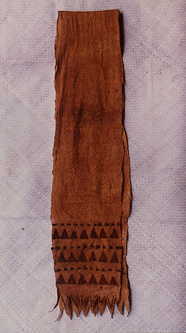
2. Cotton Sirat in ikat technique with vegetable dyes, woven by the late Samba Indai Sendi of Stampin. A) 25 x 182 cm, pieced out with commercial cloth to 462 cm. B) Uncut, 29 x 191 cm.
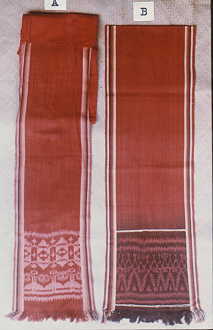
3. A) Sungkit (metallic brocade) sirat, cotton (Dylon) and silver thread, woven by Mrs. Edward Senada of Stampin. 26 x 183 cm, pieced out with commercial cloth to 623.5 cm. Hems and fringe of tanda ornamented with glass beads and brass bells. B) Cotton ikat sirat (Dylon), woven by Indai Lian of Rumah Jimbun, Ulu Balleh. 23 x 439 cm.
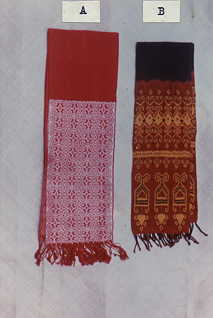
4. Tabit, seat-mat attached to back of loincloth [Iban tikai burit, Kayan tabin. Penan. Rotan in natural color and dyed black. Made by Mdm. Raden Bong, Long Main, August 2000. NB. The tiles are 8" square.
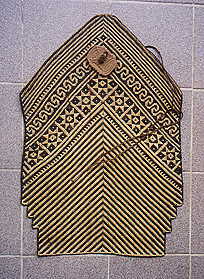
[1] p. 121ff.
[2] Westerners who early met loincloth-wearing men had great trouble finding words to describe the loincloth. The earliest writers, such as Marco Polo, use the vaguest expressions. The first attempt accurately to describe what southeast Asian men wore seems to be the following from the end of the 16th century [Cavendish p. 290]: "The people of this island [Capul, near Luzon] go almost all naked.... The men wear only a strop about about their waists, of some kind of linen of their own weaving, which is made of plantain leaves, and another strop coming from their back under their twists ["the junction of the thighs, the fork" OED], which covers their privy parts, and is made fast to their girdles at their navels."
[3] See Hald.
[4] The Minoans wore some sort of breechcloth. The Greeks wore a loincloth at the Olympic games up to a certain date. (See Thucydides History, 1.6.) Later, men exercised naked.
[5] See Gregor.
[6] Covarrubias, p. 119.
[7] See Levi-Strauss, p. 302.
[8] Which gives an interesting twist to the conquistadors' lust for this metal. See Wafer, pp.83-4, who, perhaps surprisingly for a 17th century Englishman, comments on the Panamanians' modesty.
[9] Which the ancient Greeks were also accustomed to do when exercising.
[10] Chagnon, p. 65.
[11] Some passages of traditional Bornean poetry seem to confirm this view. See the Kenyah poem Lalo-o-o-o in Rubenstein, p. 1242."The Long Bakong people...The loincloths that they wear to cover their genitals, / their loincloths are white in color, of hard stiff cloth,/ so they are always pulling them up and down, /adjusting their loosening loincloths..." Compare the traditional Hawaiian genre of the poem in praise of the chief's loincloth [malo]
[12] Masfarré, p. 24.
[13] Lim, p. 40.
[14] See Montaigne's essay On the custom of wearing clothes for the most intelligent discussion yet on this subject.
[15] Plenty of evidence shows that both the Greeks and the Romans thought trousers an indecent as well as barbarian garment. The most interesting is a passage in Hippocrates' treatise Airs,Waters, and Places [chap.22] in which he attributes the infertility of Scythian men to their practice of wearing trousers.
[16] See Bateson and Mead concerning the Balinese idea of the"separability" of body parts.
[17] See Kano and Segawa, plate 58: "IGAKUJUT-NO-ANUNURA or loin cloth of ancient time. The Yami tells us that, in ancient time when the present loin cloth was not used, the rude loin cloth was worn by fastening two pieces of the long leaf of a wild grass called Anunura..."
[18] See Ucko.
[19] I have read somewhere about a Sulawesi man who used a string strung with large beads for his breechclout belt, in order, says the writer, "to forestall abrasion."
[20] "Chawat" first attested in English in Beeckman, p. 54.
[21] A few of the many names in Bornean languages for the loincloth: Kayan: bah ; Penan: avet , iveg ; Bidayuh: taup . Certain names are perhaps related to Philippine words for the same thing,for example, Kayan bah with the Tagalog bahag.
[22] The Hawaiian and Samoan term for the loincloth is malo, in Maori maro. The Tahitians wore a loincloth, also called maro , alone or as underwear beneath their skirtlike pareu . (See Oliver v.1, p. 153.) These names are all cognate with the Malay malu.
[23] The natives of the
Americas (when they did not go naked in rainforest areas) wore a
breechcloth or loincloth. The civilized peoples of Mexico and Central
America wove loincloths almost exactly like the Bornean loincloth. Inca
men used a style fastened by a string with an apron long enough so that
a decorated fringe would show from beneath their upper tunics, exactly
like the Japanese etxhu fundoshi.
Africa shows a great diversity of men's lower body
garments, which awaits study.
Japanese men also wore the loincloth [fundoshi
] from ancient times up through WW2, either alone, or as underwear.
Many
still wear the fundoshi in Japan. This ought to counter
arguments
thatthe loincloth is a "primitive" garment.
[24] The ancient Indians
were the only Indo-European speakingpeople ever traditionally to have
worn a
loincloth. The nîvi (which means "knot," presumably a
knotted
loincloth)
mentioned inthe Atharva Veda was used as an undergarment
beneath the
skirtlike vâsas (the modern dhoti ). The later
name for
it
is kaupîna or langoti . Many references make it
clear
that
the little breechcloth was a symbol of chastity and decency. When worn
alone
by any person other than a small boy the breechcloth was a sign of
extreme
poverty. Poverty, however, was no shame if borne in following the
life
of a spiritual ascetic. The ascetic's breechcloth is also a symbol of
his
virility, which to an Indian is all the greater for being
contained.
Heroes
of romantic tales such as the story of Nala and the Dasakumâracarita
generally spend some time wandering around in a breechcloth.
Nowadays it is reported that a little breechcloth is
worn as underwear in the south of India, where not replaced by modern
commercial underpants.
Indians and other civilized peoples distinguish
between inner and outer clothing; in Borneo, no such distinction used
to exist. The loincloth is worn all by itself.
[25] Covarrubias, p. 242-3.
[26] v.2, p.129.
[27] See too a recent photograph in Chen, after p.32.
[28] See Ejau, pp. 8-9, in which the character Ula runs to save a favorite dog from the fire that is burning his garden-land, and scorches his sirat. In one of the Apai Sali stories, Apai Sali deliberately burns his sirat's tail in order to have an excuse for running off to the jungle. [Nyangoh, p. 4]
[29] M. Brooke, p. 74.
[30] Hanbury-Tenison, p.47. Cf. p. 156.
[31] See also Brooke Low's comments on colors of loincloth material and decoration in Ling Roth v.2, p. 54-5
[32] See Majlis.
[33] Pitok, p. 5.
[34] If Hose and McDougall are to be believed, the first ruler of Brunei, Awang Alak Bertatar, later known as Sultan Mohammed, wore the most extraordinarily grand tanda on record: "Like most of his subjects this warrior was a Bisaya, not indeed a civilized potentate at all, to judge by conventional standards [sic ]; for the chief mark of his royal dignity was an immense chawat, or loin-cloth, carried as he walked by eighty men, forty in front and forty behind." [v.1, p.18] I have not been able to trace this story farther than Hose, and therefore repeat it with caution. But if true, this story would show that Borneans shared with the ancient Hawaiians the notion that a chief's loincloth is a symbol of his royal prowess. Up to Hose's own time, an official at the coronation ceremony of a Brunei sultan wore a chawat over trousers to show he represented the sultan's Dayak subjects. [p.20]
[35] That is, much used recently; but the style has a history of at least 150 years. Wallace reported of the Bidayuh style during his visit: "The chawat is generally of blue cotton, ending in three broad bands of red, blue, and white..." [p. 51]
[36] See the Bidayuh poem Tingiring Nyamun Anak Ihang in Rubenstein, p. 338.
[37] Jacob anak Imang, p. 42. See also Sandin 1977, p. 39.
[38] Richards, sub voc.
[39] See photograph in Morrison, p. 72.
[40] Richards, sub voc. burong.
[41] 1966, p. 7.
[42] 15 May 1990.
[43] Richards, sub voc.
[44] Compare the scene in Visakhadatta's play Rakshasa's Ring , [act 5, after verse 11]. Indian men of the time in which the play is set wore very little, a piece of sheer fabric they draped scantily around their loins. Here Rakshasa is summoned to court, and calls for his ornaments, saying that he cannot appear without them.
[45] C. Brooke, p.202.
[46] Smith, p.148.
[47] v. 1, p. 399.
[48] v.1, p. 321.
[49] SAM, p. 33.
Bateson, Gregory, and Mead, Margaret (1942): Balinese character: a
photographic analysis. Special publications of the New York Academy
of Sciences, v. 2.
Beeckman, Daniel (1718): A voyage to and from the island of Borneo. London.
Brooke, Charles (1866): Ten years in Sarawak. reprint Oxford University Press, Singapore, 1990.
Brooke, Margaret (1934): Good morning and good night. Constable and Co., London.
Cavendish, Thomas (1587): Voyage around the whole earth. in Hakluyt, voyages and discoveries, ed. Jack Beeching. Penguin, 1972.
Chagnon, Napoleon (1983): Yanamamo, the fierce people. 3rd. ed. Holt, Rinehart, and Winston, New York.
Chen, Paul C.Y. (1990): Penans, the nomads of Sarawak. Pelanduk Publications, Petaling Jaya.
Covarrubias, Miguel (1937): The island of Bali. Alfred A. Knopf, New York.
Ejau, Andria (1964): Dilah Tanah, Borneo Literature Bureau (BLB), Kuching.
Gregor, Thomas (1977): Mehinaku: the drama of daily life in a Brazilian Indian village . University of Chicago Press, Chicago.
Hald, Margrethe (1980): Ancient Danish textiles from bogs and burials. National Museum of Denmark, Copenhagen.
Hanbury-Tenison, Robin (1975): A pattern of peoples . London.
Hippocrates (5th. c. B.C.): Works . ed. with a trans. by W.H.S. Jones, Heinemann, London, 1957.
Hose, Charles and McDougall, William (1912): The pagan tribes of Borneo . 2v. reprint 1966 Frank Cass & Co., Ltd., London.
Jacob anak Imang (1966): Ijau Berani , BLB, Kuching.
Jepet anak Achoi (1968): Sirat Sabelit. BLB, Kuching.
Kano, Tadao & Segawa, Kôichi (1945): The illustrated ethnography of Formosan aborigines, the Yami tribe. Contribution from the Shibusawa Institute for Ethnographical Research. Seikatsusha Ltd., Tokyo.
Levi-Strauss, Claude (1955): Tristes tropiques. Plon, Paris.
Lim Poh Chiang (1989): Among the Dayaks. Graham Brash, Singapore.
Ling Roth, Henry (1896): The natives of Sarawak and British North Borneo. 2v. reprint 1980, University of Malaya Press, Kuala Lumpur.
Majlis, Brigitte Khan (1984): Indonesische Textilien. Ethnologica, neue Folge, Band 10, Koln.
Martin, Karl (1894): Reisen in den Molukken. E.J. Brill, Leiden.
Masfarré, Eduardo (1988): People of the Philippine Cordillera, photographs 1934-1956. Devcon IP Inc., Manila.
Montaigne, Michel de (1595): Essays. trans. Donald Frame. Stanford University Press, Stanford.
Morrison, Hedda (1962): Life in a longhouse. BLB, Kuching.
Nyangoh, Harry (1967): Apai Sali. BLB, Kuching.
Oliver, Douglas L. (1974): Ancient Tahitian society. 3v. University of Hawaii Press, Honolulu.
Pitok, Norman Rundu (1966): Salumpong Karong Besi. BLB, Kuching.
Richards, Anthony (1981): An Iban-English dictionary. Oxford.
Rubenstein, Carol (1973): Poems of indigenous peoples of Sarawak: some of the songs and chants. Sarawak Museum Journal, special monograph no. 2.
St. John, Spenser (1862): Life in the forests of the far east. reprinted 1986 Oxford University Press, Singapore.
SAM [Sahabat Alam Malaysia] (1990): The battle for Sarawak's forests. 2nd. ed., Penang.
Sandin, Benedict (1977): Gawai Burong. Universiti Sains Malaysia, Penang.
Sandin, Benedict (1966): Tusun Pendiau. BLB, Kuching.
Smith, Harrison W. (1919): "Sarawak: the land of the white rajahs." National Geographic Magazine, v. xxxv no. 2, [Feb. 1919] pp.110-167.
Ucko, Peter J. (1969): "Penis sheaths: a comparative study." in Proceedings of the Royal Anthropological Institute of Great Britain and Ireland for 1969.
Visakhadatta (8th. c. A.D.?): Rakshasa's Ring. in Coulson, Three Sanskrit Plays. Penguin.
Wafer, Lionel (1692): A new voyage and description of the isthmus of America. ed. L.E. Elliot Joyce. Oxford, Hakluyt Society, 1934.
Wallace, Alfred R. (1890): The Malay archipelago. 10th. ed.
reprint 1983, Graham Brash, Singapore.
